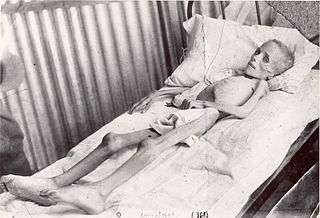Lizzie van Zyl
| Lizzie van Zyl | |
|---|---|
 Lizzie van Zyl | |
| Born |
22 April 1894 Orange Free State Republic |
| Died |
9 May 1901 (7 years old) Bloemfontein, Orange Free State Republic |
Lizzie van Zyl (22 April 1894 – 9 May 1901)[1][2] was a South African child inmate of Bloemfontein concentration camp who died from typhoid fever during the Second Boer War.[1][2][3]
Background
The British incarcerated her in a concentration camp following the refusal of her father, a Boer combatant, to surrender. Activist Emily Hobhouse used her death as an example of the hardships the Boer women and children faced in the British concentration camps during the war. She describes Lizzie as "a frail, weak little child in desperate need of good care", who was placed on the lowest rations and, after a month, was moved to the new hospital about 50 kilometres (31 miles) away from the concentration camp, suffering from starvation. Initially the publishers of Hobhouse's reports refused to publish the photograph.[3]
According to Hobhouse, she was treated harshly in the hospital. Unable to speak English, she was labelled an "idiot" by an English-speaking doctor and her nurses, who were unable to understand her. One day she started calling for her mother; a lady went over to comfort her, but "was brusquely interrupted by one of the nurses who told her not to interfere with the child as she was a nuisance." Lizzie died in 1901 at seven years of age.[4]
Photo
The photo of the emaciated van Zyl reportedly was passed from British author Arthur Conan Doyle, who served as a volunteer doctor during the Boer War, to Joseph Chamberlain.[5] Both Doyle and Chamberlain were proponents of the Boer Wars; Doyle wrote a short work The War in South Africa: Its Cause and Conduct, that justified the war.
The photo was used as propaganda, author Hélène Opperman Lewis states, to convince the British public that Boer children were neglected by their parents. The image was released with the detail that it was taken when van Zyl and her mother entered the camp. Chamberlain was quoted in The Times on 5 March 1902, saying that Lizzie's mother was prosecuted for mistreatment.[5]
Hobhouse investigated the case and was unable to find any evidence of the case or prosecution of Lizzie's mother. She located the photographer, a man named Mr. de Klerk (also a camp inmate at the time),[3] who confirmed that the photograph was taken two months after Lizzie had arrived at the camp.[5]
References
- 1 2 "British Concentration Camps of the South African War 1900–1902: Bloemfontein". University of Cape Town. Retrieved 1 April 2012.
- 1 2 van Heyningen, Elizabeth (8 June 2010). "A tool for modernisation? The Boer concentration camps of the South African War, 1900–1902" (PDF). South African Journal of Science. 106 (5–6). Retrieved 13 September 2016.
- 1 2 3 Godby, Michael (2010). "Confronting Horror: Emily Hobhouse and the Concentration Camp Photographs of the South African War" (PDF). Department of Historical Studies. University of Cape Town. Retrieved 25 August 2016.
- ↑ "The Concentration Camps". Boer.co.za. 21 May 1995. Retrieved 3 June 2013.
- 1 2 3 Hélène Opperman Lewis. "Lizzy van Zyl". Retrieved 25 February 2015.